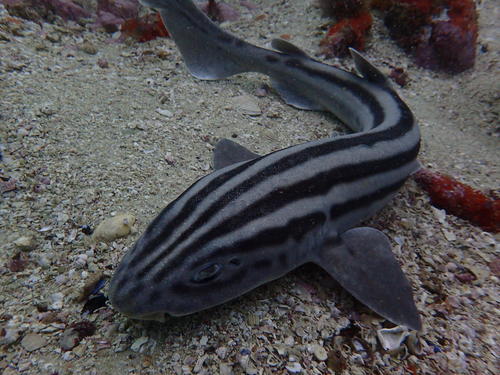
Pyjama Shark
The Atlantic Bluefin Tuna (Thunnus thynnus) is a highly migratory, large pelagic fish renowned for its size, speed, and commercial value. As one of the top predators in the marine ecosystem, it plays a crucial role in maintaining the balance of ocean life. This species is also notable for its unique physiology, including its warm-bloodedness, which allows it to thrive in a wide range of water temperatures.
5 15 years
Lifespan
90 - 110 cm
Length
Near Threatened
Conservation Status
5 km/h
Swimming speed
Carnivorous
Diet
Sedentary
Migration
Appearance Overview
The Atlantic Bluefin Tuna is renowned for its large, streamlined body, built for speed and endurance.
Coloration
Metallic dark blue above, shimmering silvery-white below
Body Shape
Torpedo-shaped, designed for efficient swimming
Fins
Two dorsal fins, the first depressible; a series of small finlets behind the second dorsal and anal fins
Length
Up to 13 feet (4 meters), commonly around 6.5 feet (2 meters)
Weight
Up to 2,000 lbs (900 kg), commonly around 550 lbs (250 kg)
Diet
Carnivorous, feeding on a variety of fish, squid, eels, and crustaceans.
Feeding Behavior
Highly active predator, using its speed and agility to hunt. Often hunts cooperatively, herding prey into tighter formations.
Social Behavior
Forms large schools, sometimes segregated by size. Known for long migrations across oceans.
Commercial Relevance
Extremely high value, especially in the sushi and sashimi markets, where its fatty flesh is considered a delicacy.
Conservation measures
Subject to strict fishing quotas and regulations by international bodies like ICCAT. Efforts include monitoring populations and enforcing catch limits.
Status
Endangered
Threats
Historically overfished to near extinction. Other threats include bycatch in fishing gear and habitat degradation.
Habitat Distribution
Depth Range
Surface waters to depths of over 3,000 feet (1,000 meters)
Geographic Range
Widely distributed across the North Atlantic Ocean, including the Mediterranean Sea, and the Gulf of Mexico.
Preferred Environment
Prefers temperate and subtropical waters; undertakes extensive transoceanic migrations.
Reproduction and Life Cycle
Breeding Habits
Spawns in warm waters, primarily in the Mediterranean Sea and the Gulf of Mexico. Spawning typically occurs from May to July.
Development Stages
Eggs hatch into larvae, which are planktonic. Juveniles grow rapidly, feeding on a variety of prey. Growth rates can vary depending on environmental conditions.
Fecundity
Highly fecund; a single female can produce up to 30 million eggs per spawning season.
Maturity Age
Reaches sexual maturity relatively late, at around 4-8 years of age.
Faqs about Pyjama Shark
Where can Atlantic Bluefin Tuna be found?
Atlantic Bluefin Tuna are found in the Atlantic Ocean, from the Mediterranean Sea to the Gulf of Mexico and beyond.
How long do Atlantic Bluefin Tuna live?
They can live up to 40 years, though this is becoming increasingly rare due to overfishing.
Do Atlantic Bluefin Tuna migrate?
Yes, they are highly migratory, traveling thousands of miles across oceans for feeding and spawning.
What do Atlantic Bluefin Tuna eat?
They primarily feed on smaller fish, squid, and crustaceans.
Are Atlantic Bluefin Tuna warm-blooded?
They are warm-blooded, which is unusual for fish, allowing them to maintain a higher body temperature than the surrounding water.
How fast can Atlantic Bluefin Tuna swim?
They are among the fastest fish in the ocean, capable of bursts of speed up to 43 mph (70 km/h).
How many eggs can a female Bluefin Tuna lay?
Females can release millions of eggs each spawning season.
When do Atlantic Bluefin Tuna reach maturity?
They reach sexual maturity at around 4-8 years of age.
Copyright @ Nature Style Limited. All Rights Reserved.
 English
English